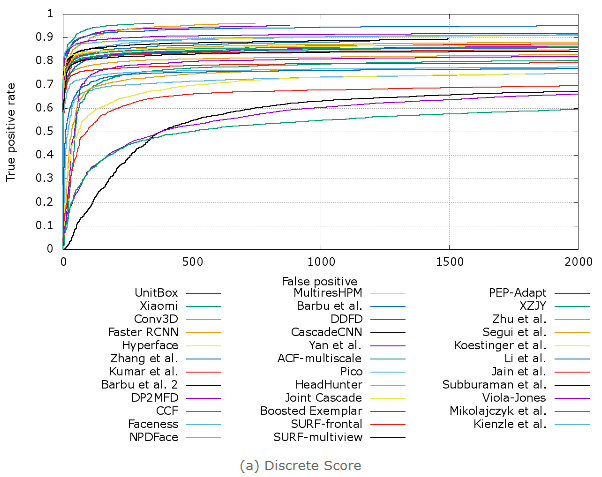Following the Baidu Deep Learning Institute, Tencent Excellence Chart, and Face++, Xiaomi’s latest face detection algorithm has scored the first results in the industry’s most authoritative FDDB dataset.
According to Xiaomi’s co-founder Huang Jiangji’s public information, Xiaomi’s new algorithm is based on the Fast RCNN Bootstrapped by Hard Negative Mining, which uses deep convolution detection networks to learn face and non-face features at the same time. To accurately identify the position and size of the face.

Lei Feng network (search "Lei Feng network" public number attention) contacted the millet co-founder Huang Jiangji who participated in this project, he said that the millet face detection improved the existing methods, especially for relatively vague face Obvious optimization, but the specific details will not be known until the publication of the relevant paper.
Of course, what we need to understand before this is that face testing can be divided into face recognition, face detection, face expression, face age, face gender, and so on, of which face recognition and face detection are the most mainstream. The two directions.
Face recognitionThe purpose of face recognition is to find out the face in the picture and then identify who the face is. At present, there are most data sets for global face recognition, such as WebFace, MegaFace, and LFW (Labeled Faces in the Wild). LFW is a famous collection of face images in the field of face recognition research. The LFW library has a total of 13,233 images of 5,749 individuals. Of these, 1680 have two or more images, and 4,069 have only one image.
For example, Facebook Deepface, Prof. Tang Xiaoou's DeepID and Face++ of the Chinese University of Hong Kong have all performed tests on the LFW.
Face DetectionIn fact, the task of face detection is a bit simpler than face recognition. It only pays attention to the first step of the former, which is to give a picture and find out the area of ​​the face (elliptical or matrix) to achieve the goal. Now.
FDDB (Face Detection Data Set and Benchmark) is the most authoritative face detection evaluation platform. Like FDW, FDDB is a face database of the University of Massachusetts. It contains 2,845 images and a total of 5,171 human faces as a test set. The scope of the test set includes: pictures with different poses, resolutions, rotations, and occlusions, as well as grayscale and colormaps. The standard face tagging area is elliptical. Xiaomi's face detection test was conducted at the FDDB.

"The detection and recognition are based on feature extraction. The detection is equivalent to having a sufficient number of boxes on a picture (for example: 20X20 box, each pixel is filtered one by one.) The position of the face can be identified first, then selected The boxes are then screened one by one according to the pixels inside the marquee,†said Yu Hongyi, CEO of Ubisoft.
The popular point is to give a random frame in the picture, determine whether the frame is a face, and then move the frame to determine whether it is a face or not. This process is called "sliding window" in the academic field and is a process of feature extraction. Therefore, in a picture, at least tens of thousands of frames need to be separately extracted to identify faces.
In the FDDB dataset, the position of a human face will be well-shaped with an oval frame. The area identified by the automatic algorithm and the area where the real face is required are overlapped (intersection) by comparing and combining more than one threshold (for example, 50%) even if the recognition is accurate.
What is the level of Xiaomi's face detection algorithm?Lei Feng consulted with several people in the industry to see how they evaluated Xiaomi’s face detection algorithm.
Wu Pengcheng, founder of Shentu Zhizhi:
The FDDB dataset has two groups, one with the public method and the other with no public method. Xiaomi disclosed this method in a particularly kind manner, so everyone can reproduce it.
From the results, they performed particularly well in the open method group, which is basically close to the best in the group of undisclosed methods.
In addition, Xiaomi also improved the faster RCNN to do face detection. The faster RCNN was originally proposed by Sun Jian (Chief Scientist of Face++) to use for object detection. Many domestic use it for face detection, including our own. Really good.
Tu Tu technology CMO Wang Nan:
Technical indicators are only one aspect, but also depends on how to land, because the difficulties are in commercialization.
Millet has a wealth of resources as a large company, BAT is involved in this area, face recognition is still the simplest part.
Zhao Jinglei, founder of Reading Technology:
Blurred pictures can affect the accuracy of detection and recognition, and can be optimized by algorithms and data. The fuzzy face optimization used by Xiaomi should brush a lot of data. The FDDB brush data can be done by everyone, but the actual application is another matter.
Tuop Technology founder Li Mingqiang:
Judging from this evaluation result, Xiaomi's face detection has done a good job, but everyone on this list is similar, and there are statistical errors in LFW, FDDB, and even ImageNet.
Ubisoft Intelligent CEO Zhao Hongyi:
A single brush list is of little significance. Some domestic companies have maliciously brushed lists on these FDDB data sets, but it should be noted that face detection not only requires accuracy but also speed.
There are also industry sources told Lei Feng network, Xiaomi this performance is indeed very good, but it can not explain what the problem. The FDDB library has only 2,000 images, and the Wider Library is two or three orders of magnitude larger than its photographs, and the single image has more than one hundred faces. Although the FDDB is the mainstream data set, it is not challenging.
From the point of view of several industry experts, it can be concluded that Xiaomi’s ability to beat other companies and institutions on the run points has confirmed the ability of his face detection algorithm, but back to the application layer, the significance of running points is greatly reduced. Xiaomi official has confirmed that this technology will soon be applied to the MIUI face album, so the specific performance, we will continue to pay attention.
Recommended reading:
For Xiaomi’s black technology, stakeholders’ spectators say so
In addition to Xiaomi, these companies are also brilliant in the FDDB.
